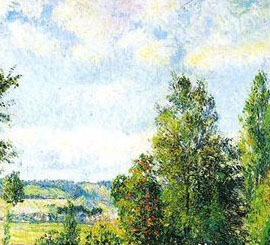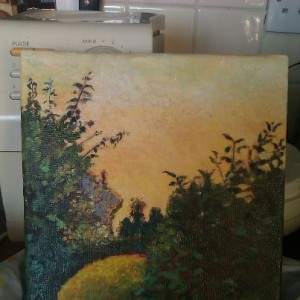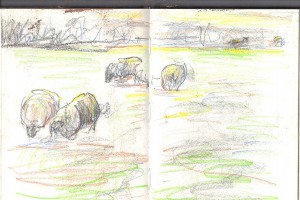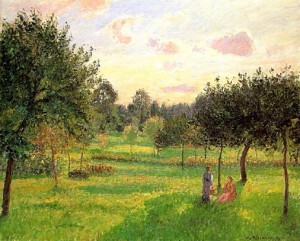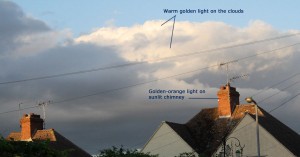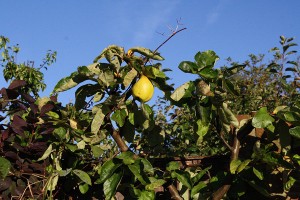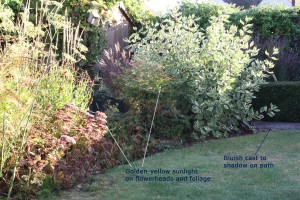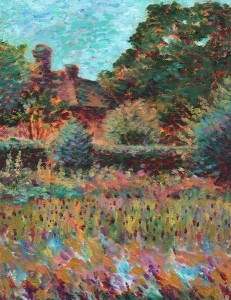September light and the golden hour
September 23, 2012
Some thoughts on September sunlight
Above: detail from Camille Pissarro’s “Mirbeau’s Garden, The Terrace”
Though you may be have been expecting a third blogpost on horse eyes this weekend, I cannot resist going off at a tangent for a moment. The late summer light here in Hertfordshire in the south-east of England has been so special that I must comment on that before returning to the “horse eyes and expression” article.
During the past week or so, the sunlight here has reminded me of the golden light that I enjoyed around the coast if southern France this July. Following our wet, cold mid-summer, each day of British sunshine is an unexpected pleasure. But it is not just that. The special quality of the light is largely due to the sun lingering low in the sky before 9:30am and after 3:30pm, while still being strong enough to cast a golden glow.
Artists need to work quickly as the light changes
Sometimes the sky fills briefly with colour, or I see my surroundings transformed for a few moments by the golden glow of the sun. Special light effects last no more than 20-30 minutes and I do not have the skill to capture them well with my camera. The best option is to sketch as rapidly as possible. The little oil painting above was painted at 6:45am for quarter of an hour on four consecutive clear-weather mornings in early September.
I started this exercise on impulse when the view of the sunrise caught my eye just as I turned to empty the dishwasher one morning. For speed, I threw an old protective sheet over the kitchen worktop and grabbed a canvas just 19cm square.
I attempted a quick snap of the same view on my phone which was to hand. See how the camera reads the sunrise as a complete white-out. This does, however, record some bright colours on my palette:
On another occasion, I noticed the afternoon sunlight slanting low over the backs of the sheep, above, as I was driving home. I skidded to a a halt and grabbed my sketchbook, a graphite stick and and coloured pencils. This was from a sketchbook from last autumn and, from the hungry and woolly appearance of the sheep, I think it may have been from November rather than September:
The “Golden Hour” lengthens in autumn
When we are lucky enough to experience bright autumn sunshine, there is an extended “golden hour” effect. Artists and photographers refer to the golden hour as being the period of dusk or dawn when the sun is low in the sky. Due to the scattering of blue wavelengths of light by the atmosphere, the light from the sun appears more golden-orange than at midday. At the same time, the sky can appear more richly blue.
Objects illuminated by sunlight appear more golden, while their shadows become somewhat blue or purple.
In the Pontoise painting, above, by Camille Pissarro, the grass becomes golden where sunlight falls upon it. The setting sun is, I suspect, just to the right-hand side of this view, which is why the visible sky is yellow rather than blue.
Though I am no photographer, I have attempted to illustrate the September light effect with photos of my garden and surrounding areas. In the morning rooftop picture, below, see how the chimneys are given a golden-orange cast by sunlight falling on them:
Below is a humble dog rose shrub with mid-green leaves. With golden sunlight coming from the right-hand side of the picture at about 8:30am yesterday, part of each sunlit leaf appeared to glow a warm yellow colour:
Below are the tops of shrubs seen yesterday morning, with the sun positioned to the left o the picture. Warm-coloured sunlight cast a golden glow from the left side of the picture onto regions marked (1). The parts of the shrub in shadow are not only darker in tone but are also much bluer in hue, as at (2):
The actual colour of most leaves in the garden here is still green, i.e. the colour that they would appear under white light. The occasional leaf is starting to change to red, brown or yellow. This early autumn leaf colour, in combination with the “golden hour” light effect, contributes to the golden appearance of plants in September. It has been a terrible year for fruit in my garden, but there is one golden quince:
Below are ornamental grasses, Sedum and other garden plants. The tall Calamagrostis Foester grass is loved by gardeners for its ability to “catch the light” on its eye-catching vertical stems. My camera has reduced the golden quality of the light here but, even in this photo, there is the suggestion of a yellow-gold light cast over these plants. In contrast, notice how blue the path looks in shadow here:
And a hot-weather midday picture
The above photos and paintings all relate to “golden hour” lighting around dusk or dawn. In contrast, below is a rapid oil painting that I created around midday on a hot early September day this year. I was looking across a meadow in Gustardwood with the sun itself just out of the picture. There were crickets chirruping in the field, the sun was almost dazzling and the light seemed to shimmer over the plants. Again, my try at photographing the scene just ended in silhouette and the whiting-out of all colour. Here is my experimental attempt to make sense of the midday light effect using marks of mostly unmixed oil paint:
For this one, I worked on a canvas that I had previously painted a warm orange-peach colour (using a mixture of acrylic quinacridine purple and cadmium yellow). The marks of cool blue and green oil paint against the orange ground give the painting some of its vibrancy. In places, I have used bright red paint marks in amongst the green, and these complementary colours together also produce a zingy effect.
